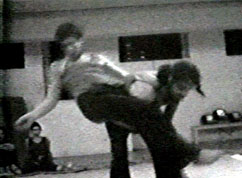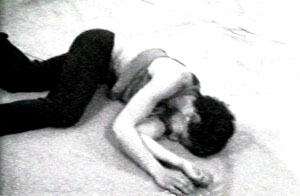
Contact Improvisation: A Question?
Daniel Lepkoff
May 2008
My understanding of the original intention of Contact Improvisation as an art event was to display to the public the body's innate ability to respond physically to its environment. Implied is an interest in the diversity of people's survival strategies and an indication that this spontaneous physical material can be viewed as danced composition.
Designing a performance form that would shunt any stylistic or aesthetically driven impulses a dancer may have, revealing a level of physical functioning that is ordinarily unconscious and material that is typically avoided in performance, is a tall order to say the least. Looking back, I think Steve Paxton experienced a moment of genius in creating the performances that were called Contact Improvisation.

Steve's ploy was to put the dancer's body into unusual, disorienting, and often emergency situations, pulling the rug out from under our feet so to speak. Rather than a predictable and familiar environment of support, such as the sole of one's foot meeting the fixed surface of the floor, in Contact Improvisation, one finds oneself in circumstances that demand accessing support from any area of one's own body
surface, in physical contact with any area of another person's body surface, both of which are in motion. In this situation one is not able to rely on habits, the reflexes take over, and the rest is history.
The underlying technique needed to prepare for and survive the surprises of a Contact Improvisation duet is to pose and maintain a question:

- What is going on when I move?
- Where is my center?
- Where is down?
- What surfaces of my skin are being touched or touching?
- Which of these surfaces offers support?
- Where do I think I am going?
- Where am I able to go?
- What am I not aware of?...and so on
This questioning, rather than formulated within one's verbal mind is formulated and resides within the tissues of the body: bones, muscles, organs, nerves, and brain.
What happens when, after a few years of practice, what was once an unpredictable emergency situation becomes familiar? This point, reached fairly quickly, is the juncture at which the direction and essential nature of Contact Improvisation comes up for grabs. The never-before-seen movement pathways, the never-before-experienced physical sensations, or the never-before-imagined relationships with another person that emerge from the experience of dancing Contact Improvisation all can be taken as a definition of the work, rather than the physical questioning that is the ground from which this bounty of innovative material springs.

The idea that a question can be the definition of a movement form is sophisticated. The dominant association triggered by the word form is perhaps the idea of the shape of a physical object. In the case of Contact Improvisation however, the word form refers to a synaptic architecture, a readiness to receive a particular band of real time information. What is commonly referred to as "the duet form" has no knowable outer form.
If Contact Improvisation is the image of what a Contact Improvisation duet looks like, or an agreement to agree with ones partner on a set of prescribed exchanges, however numerous and however graceful these exchanges may be, that proposition is finite. If Contact Improvisation is the physical act of posing a question about ones own present circumstance, then the work is ever expansive and has applications to dance well beyond the manifestation of the duet interaction.

What does one visualize when entering a Contact Improvisation duet. What do you need to know? What do you imagine?
Postscript:
Back in 1972 Contact Improvisation was a ten day performance project led by Steve Paxton. As a participant I listened, followed, and tried to manifest physically what Steve was looking for. I'll never be 100% sure of exactly what he had in mind. Whatever it was that I did understand, touched me, soaked into my skin, and in large part set me on my path as an artist.
My own fascination in dancing Contact Improvisation was the discovery that through my physical senses I can gather information directly from my environment, that using my own powers of observation I can shift my perspective, have new perceptions, and free myself from my own conventional/habitual ways of seeing.
I began to practice maintaining an intensely physical state of questioning without an emergency situation to force me to do so. In order to accomplish this task, with no lapses of awareness, I discovered that my attention needs to be constantly in motion. Noticing what I am noticing is the easy part, noticing what I am not noticing is a crucial challenge. When my attention stops moving my interpretation of what is happening becomes fixed, my vision becomes conventionalized, and so the questioning disappears. Perception follows attention. Contact Improvisation placed my attention on an illusive subject and that in turn engendered new perceptions.
It has been an incredible and also confusing journey to participate and observe as Contact Improvisation spread around the globe. Some of the developments and directions the work has taken have not aligned with my own understanding of its essence. Does the name name what I think it is? - or - Does it name something else!!
Sometime in the mid '80's, slowly and not without a struggle, I came to realize that the definition of Contact Improvisation was in fact up for grabs, that my own interests were specific, distinct, and best served by stepping away from an association with the label Contact Improvisation. I could then define and explore my ideas without qualification.
Almost four decades later, with more distance, I've decided to decide that however much Contact Improvisation is codified, presented as a collection of 562 techniques, made to be entertaining, dressed to be pretty or graceful, shaped to be therapeutic, practiced in rooms filled with social interaction and conversation, used as a basis for building a community, etc. ultimately it's initial stance of empowering an individual to rely on their own physical intelligence; to meet their moment with senses open and perceptions stretching and compose their own response, remains intact.
Daniel Lepkoff - January, 2010
Images:
Daniel Lepkoff &
Steve Paxton dancing
Contact Improvisation at
L'Attico Gallery
Roma, Italy, 1973
Stills from video shot by: Steve Christiansen
Comment:
When I believe I know where down is, I am always wrong!
Only gravity has that information.
If I am not asking gravity for the direction of down, my idea cannot be correct.
In this work knowledge can only be a question!
What a relief!